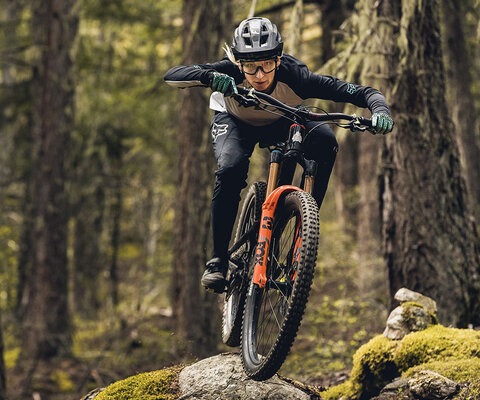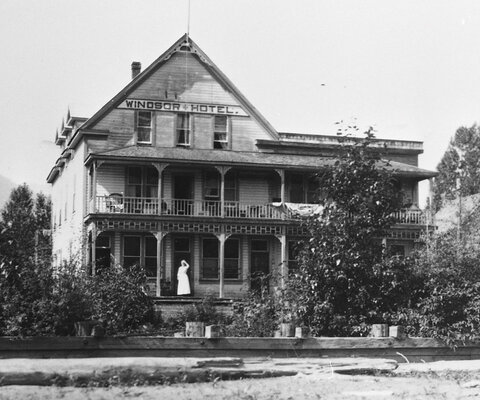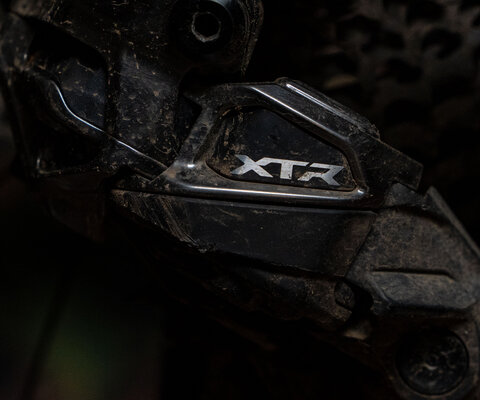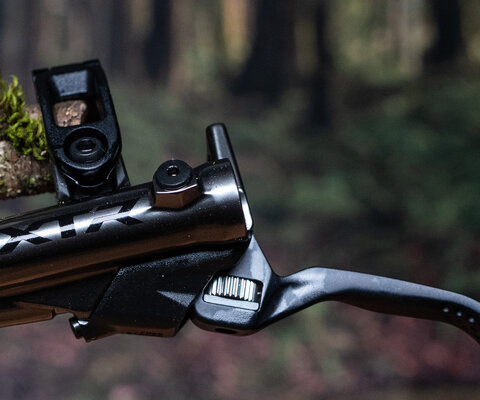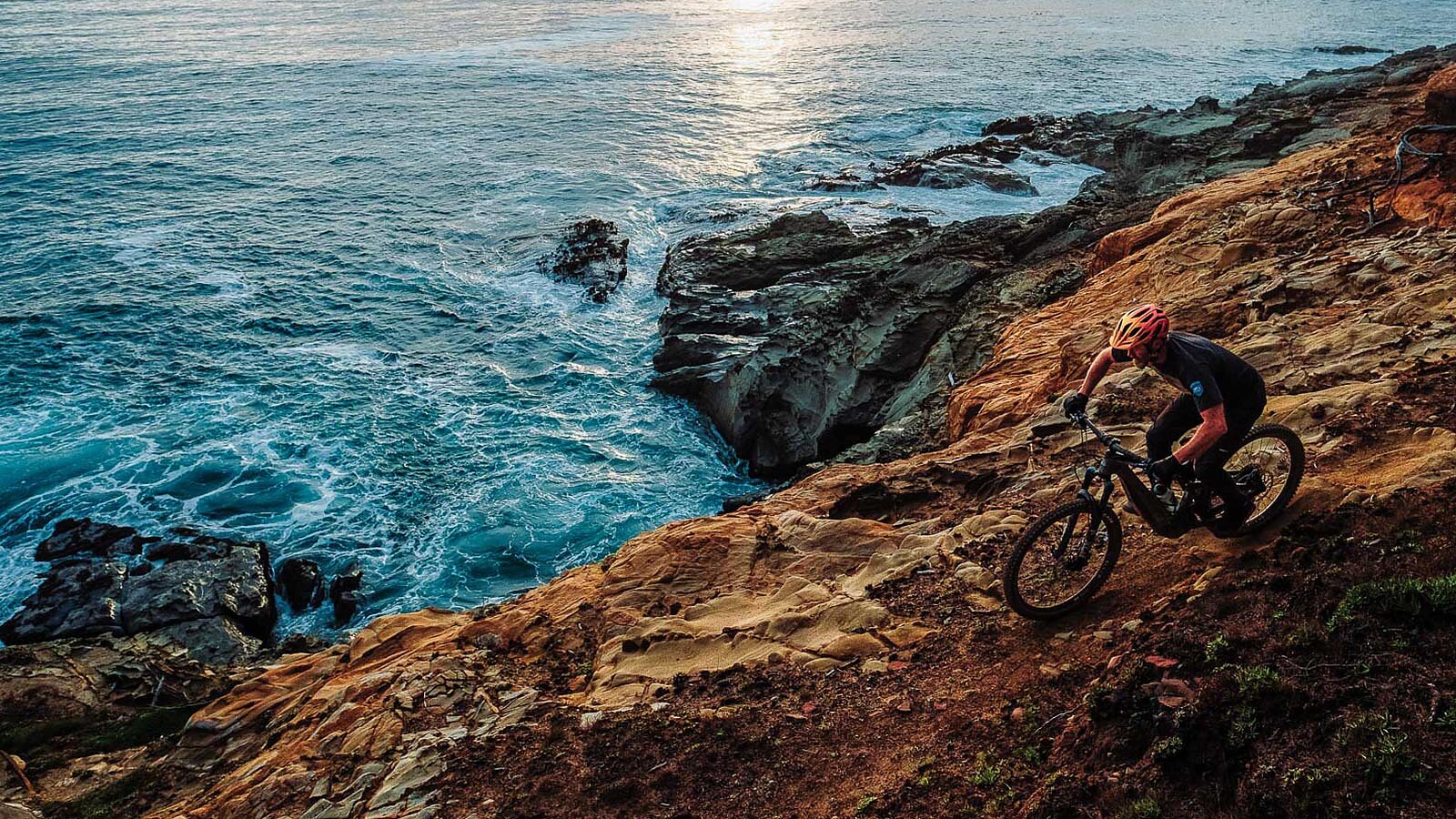
Rogue Wave A Confluence of Characters Revitalize Oregon's Wild Southern Coast
Words and Photos by Aaron Theisen
At The Crow’s Nest in the southern Oregon coastal town of Gold Beach, over a plate of fish tacos and under the gaze of mounted boars and framed Budweiser posters, Dave Lacey excitedly scrolls through digitized, historical topographical maps, buzzing at the backcountry mountain biking possibilities on nearby national forest land.
A man approaches Dave from a nearby table with a mischievous glint in his eye. He knows Dave. Here, in this community of 2,000 people, everyone knows each other.
“You know what the problem is with you, Dave Lacey?” the man says, his big beard bobbing over his hickory-and-high-viz shirt as he affably claps Dave on the shoulder. “You’re trying to make money off people coming here and having fun!”
Halfway down its 360-mile length, the orderly Oregon coastline begins to ripple and bend as several rivers pour into the Pacific Ocean. Locals call it the “Wild Rivers Coast,” with wild applying to more than just the terrain. This is still the Oregon of sasquatch sightings and secluded beaches, where forested summits crowd a little bit closer, and seaside cliffs tower a little bit higher than areas farther north.
Along the historic, coast-hugging Highway 101, a string of small towns—Coos Bay, Bandon, Port Orford, Gold Beach, Brookings—rely on fishing and logging as their lifeblood. A five-hour drive from Portland and with few direct connections to the Interstate 5 corridor, the region has more in common with northern California than more populated parts of Oregon; for decades, residents have joked—well, most of them are joking—about seceding from the Beaver State and establishing “Jefferson,” an independent state comprising southern Oregon and the northernmost counties of California. Among these blue-collar communities, where Humboldt County hippies coexist with those slinging crab pots and chainsaws, a group of forward-thinking mountain bikers has begun reopening old backcountry trails in the Rogue River wildlands and building new trail systems on cut-over coastal timberlands.
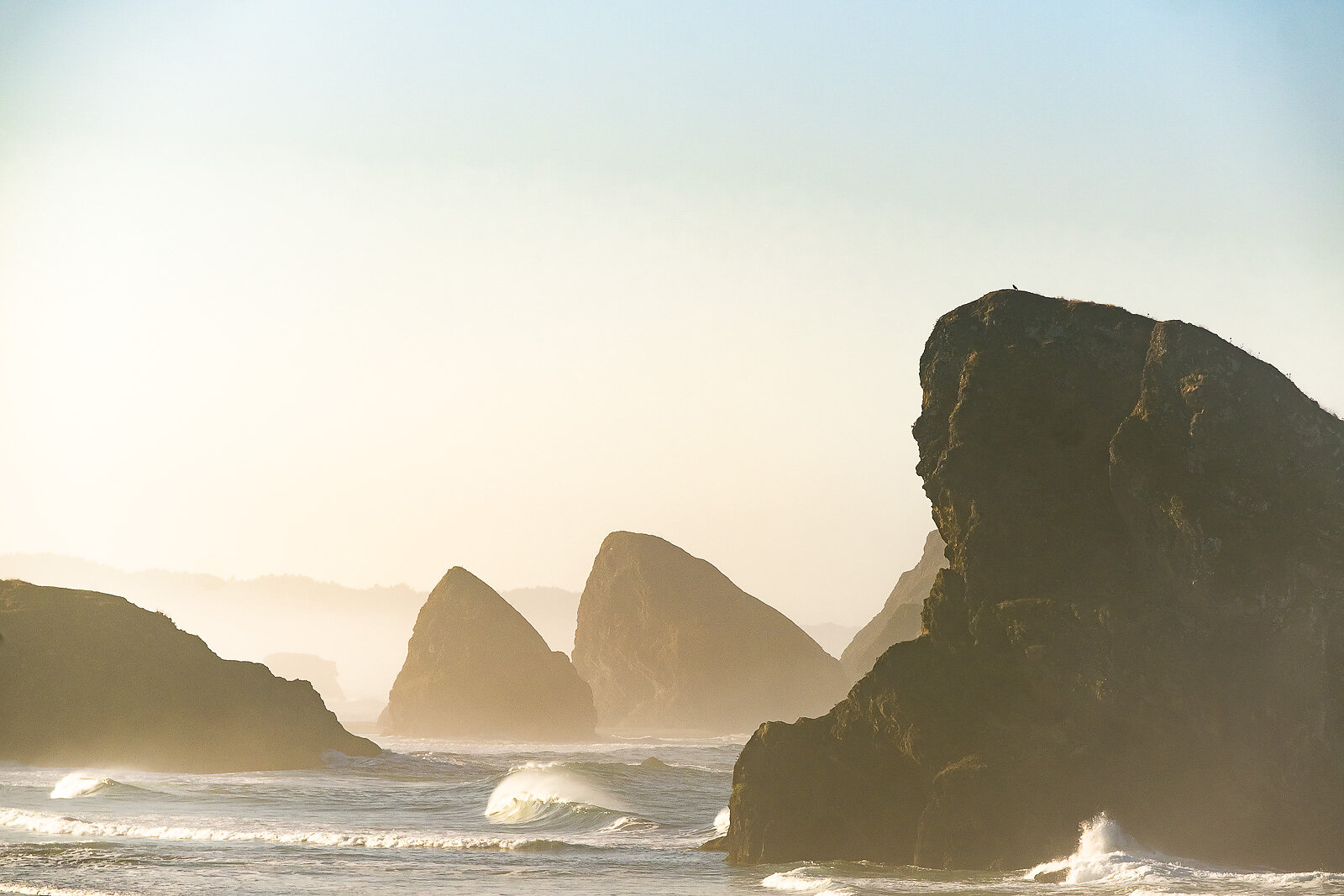
“I DIDN’T KNOW WHISKEY RUN WAS GOING TO BE BUILT WHEN I BOUGHT THE LAND. I DIDN’T KNOW I WAS INVESTING IN A COMMUNITY THAT WAS ABOUT TO BUILD A 30-MILE TRAIL SYSTEM.” —Eddie Kessler
Lacey himself came to the southern Oregon Coast a decade ago to have fun and effectively never left. The uncrowded natural beauty of the area he found while on a surf trip to the area was enough for him to pack up his van and move to Gold Beach.
Although he describes himself as a “surfer who rides a mountain bike sometimes,” Lacey used to ride every day before moving to the coast from rural eastern Washington. Once there, however, the lack of any real trail infrastructure scuttled his cycling lifestyle. The handful of miles of narrow sidehill, shoreline singletrack at Cape Sebastian State Scenic Corridor just south of Gold Beach wasn’t enough to keep him interested in the sport.
Lacey started a tour company, South Coast Tours, and began participating in rural tourism networking sessions hosted by Travel Oregon, the state’s tourism department. One of the priorities that arose during the workshops was the need for mountain bike trails on the coast. Lacey led a group tasked with prioritizing potential trail systems in the region. It quickly found a willing potential partner in Coos County, which owns tens of thousands of acres of working forest within its boundaries, all of it unencumbered by federal red tape. The resulting Regional Trails Plan proposed, in addition to the restoration of existing trails, the construction of a new singletrack network, Whiskey Run, on county land.
Around this time, Eddie Kessler, the owner of Ptarmigan Ptrails, moved his family and his trail construction business from Alaska to Oregon. Having both grown up in Florida, he and his wife Erin wanted to raise their young daughter near the ocean and still have the opportunity to work on trails. The Kesslers struck ground on a homestead outside the tiny community of Port Orford, a half hour drive north of Gold Beach, and Erin opened a bike shop, Pineapple Express, in town.
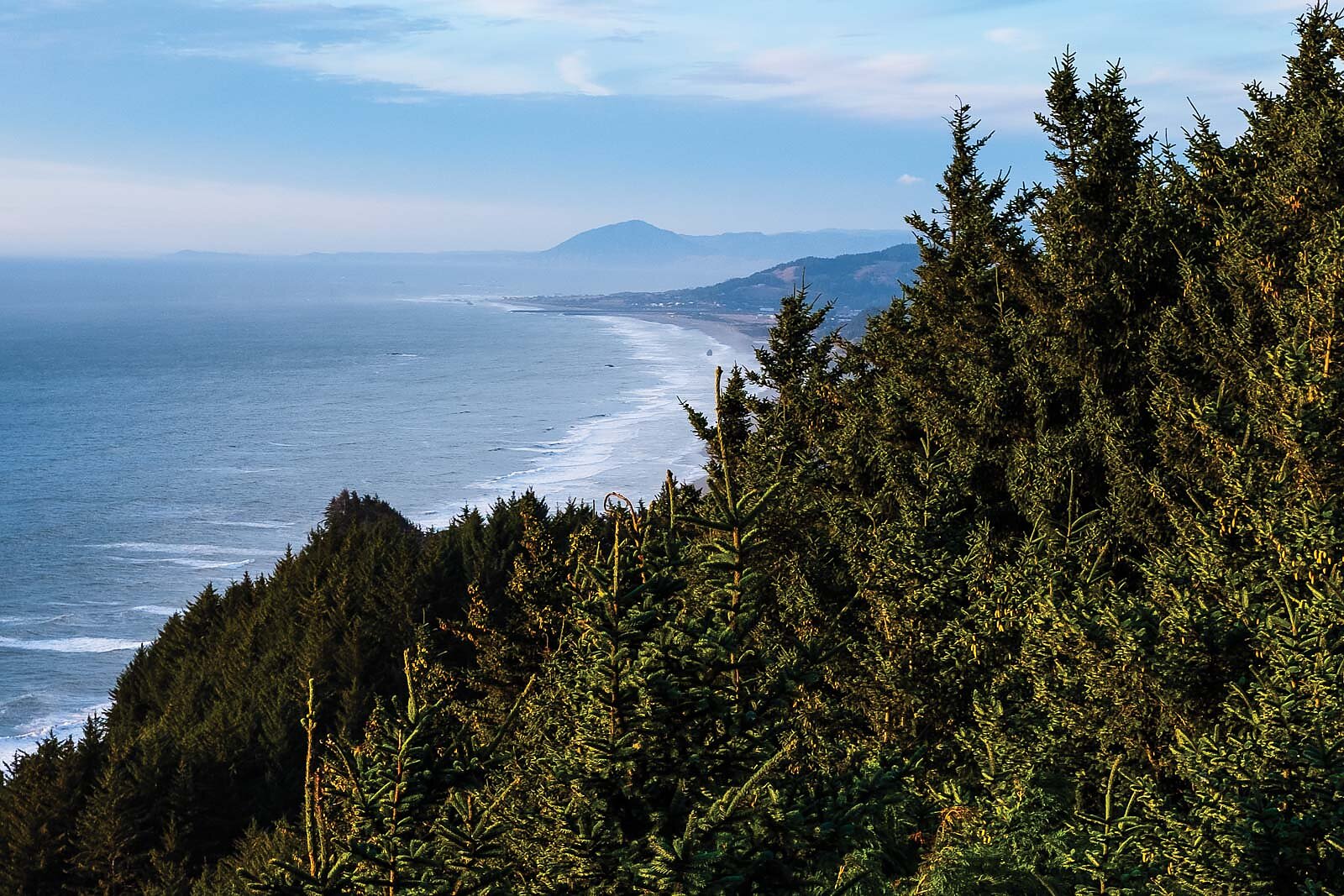
“I didn’t know Whiskey Run was going to be built when I bought the land,” Kessler says. “I didn’t know I was investing in a community that was about to build a 30-mile trail system.”
At the beginning of 2016, Wild Rivers Coast Mountain Bicycling Association (WRCMBA) formed to support the trails’ working group. County officials overwhelmingly supported the idea of a purpose-built bike trail system and, in 2017, the county received a grant from the Recreational Trails Program (RTP), and Ptarmigan successfully bid on construction of 30 miles of purpose-built singletrack 10 minutes north of the golf-course-and-gallery community of Bandon.
“We caught lightning in a bottle with Whiskey Run,” Lacey said.
Over the course of five years and three grant-funded phases of about ten miles each, Ptarmigan constructed 30 miles of singletrack at Whiskey Run. Kessler advocates for maintainable, rather than sustainable trails, especially in working forests where the life cycle of a trail doesn’t have to be measured in decades and the environmental impact is weighed not against virgin nature but by impending clearcuts; it’s not a matter of if certain parcels of Whiskey Run will be logged, but when. The county logs on a schedule, though, so there’s no chance of Ptarmigan trailbuilders showing up to the land and being blindsided by bulldozers.
“Knowing that things are going to be impacted lets us go a little deeper on features,” Kessler says. “You think, ‘This is going to be logged in three years, so is our trail going at a 15 percent grade for 200 feet going to have a greater impact than denuding the landscape?’”
The aesthetic beauty is in the tread rather than in the trees. Stripped of roots, the already rock-free soil sculpts easily, and Ptarmigan has learned to push the limit of what the soils can sustain—something Kessler calls a “hyperkinetic flow state.” And it shows, from winding beginner trails such as Hollerback Trail, to the stump step-downs of double-black Down the Hatch, and steep, root-choked loam of Speakeasy and Prohibition on the newest section of Whiskey Run, within the Volstead complex.
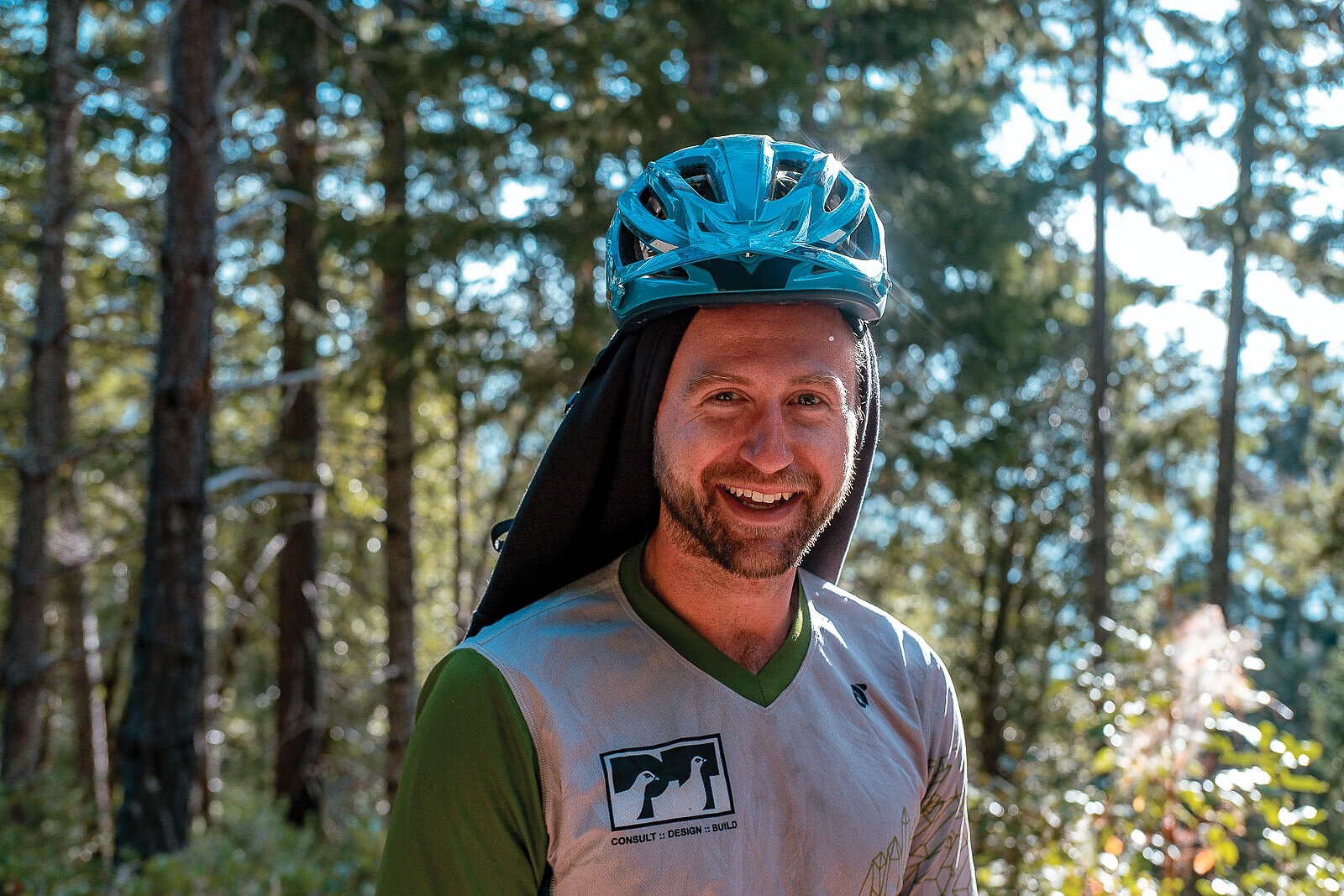
Sean Rogers, one of Ptarmigan’s trailbuilders, believes the constant tinkering and reconstruction of trails stems from Kessler’s surfing influence, who, he says, thinks about trails “like riding the dirt wave.”
That sanguine surfer philosophy, in addition to half a decade of homesteading in Port Orford amidst the unceasing onslaught of saltwater and six feet of annual rainfall, taught Kessler that nothing lasts forever.
“Everything is atrophy; as soon as you’re done building a house it’s falling apart,” he says. “Same goes for trails. People ask, ‘What are we gonna do when it’s logged?’ ‘We’re gonna fucking rebuild it and it’s gonna kick ass.’”
In the short term, the dirt, as good as it is, takes a pounding. Despite being on the coast, Bandon receives about 75 percent of the annual rainfall of the northern Oregon coast, with most of that deficit occurring in peak summer riding months.
Fortunately, WRCMBA has a dedicated crew of volunteers. For most days of the week, that includes Jerry Gross, WRCMBA’s board co-chair representing the northern half of its territory, including Whiskey Run. Born and raised in Coos Bay—less than twenty miles north of the trail system—Gross retired from plumbing a few years ago and took up trail maintenance, trading one clogged drain for another.
“I grew up riding a dirt bike and I was a bit of a hellion, and a lot of it is the guilt of what I made a mess of or tore up when I was a kid,” Gross says. “I guess I am trying to redeem myself; maybe the trail gods will look favorably upon me someday if I put the hours in.”
While he leads club work parties and works several days a week completing solo trail maintenance, the gregarious Gross serves as a one-man welcoming committee, spreading the word of Whiskey Run and the club’s efforts to build more trail systems like it to an increasing number of out-of-state license plates that grace the parking lot.
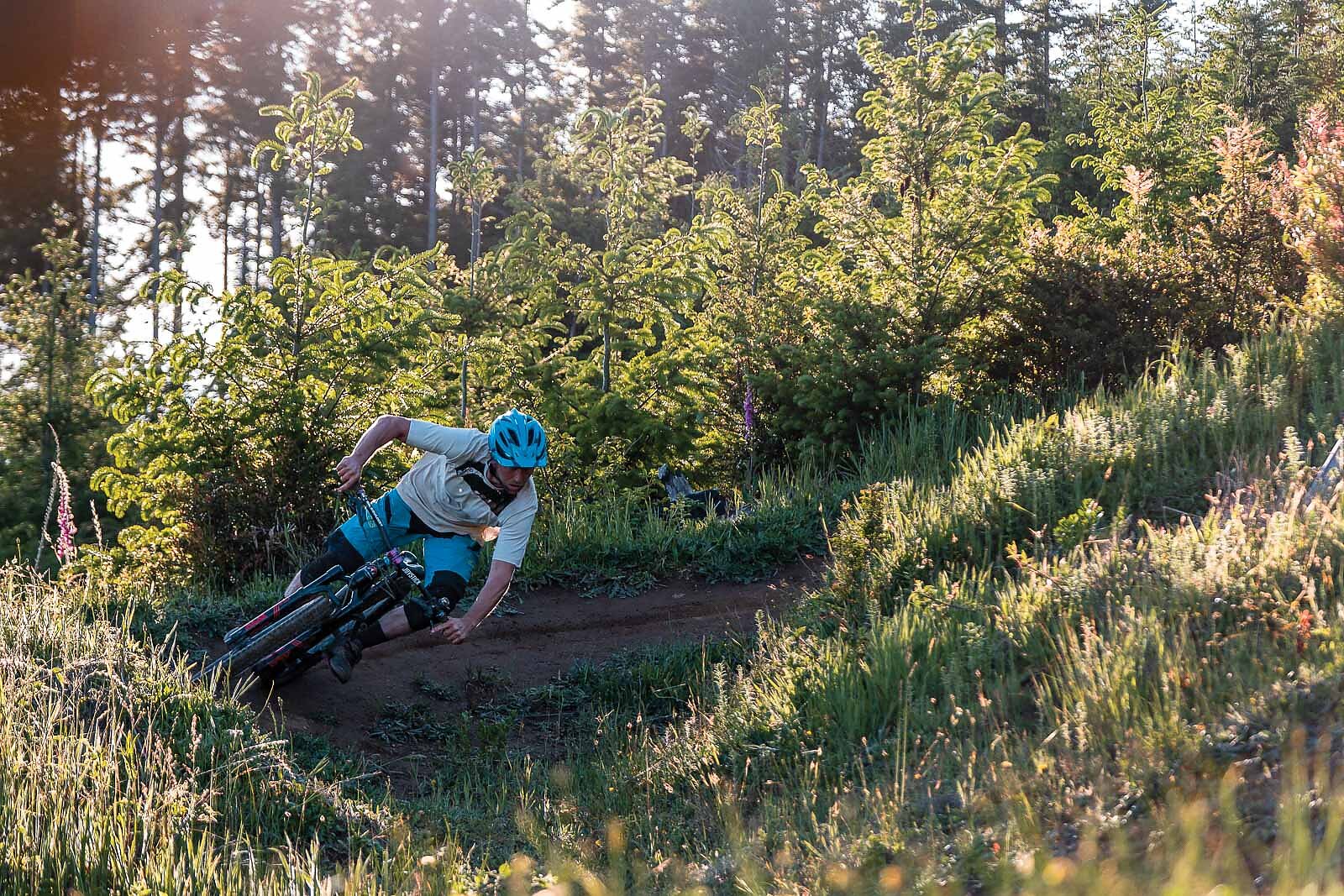
“IT’S EASY TO BUILD A TRAIL SYSTEM; IT’S HARDER TO BUILD A COMMUNITY HUB THAT COMES WITH IT. WHISKEY RUN IS THAT.” —Sean Rogers
It’s not just out-of-towners who have benefitted from the 30-mile trail system: the local National Interscholastic Cycling Association team has won the state championship several years running against teams from mountain bike boomtowns such as Bend. The young riders credit having a great place to train with their success.
“It’s easy to build a trail system; it’s harder to build a community hub that comes with it,” Rogers says. “Whiskey Run is that.”
While WRCMBA took its first steps with Whiskey Run, it also began exploring the possibility of reopening a network of trails along the Lower Rogue River near Gold Beach, some 60 miles south of Bandon in Curry County. Cradling the Lower Rogue River, the Siskiyou Mountains span the border of Oregon and California and encompass an area of remarkable biodiversity. The range also bears the visible scars of the 2002 Biscuit Fire which burned through 500,000 acres as the second-largest forest fire in Oregon’s history. Trails here—mostly old, mule-pounded miner trails-turned-moto-tracks— roll from the massive boles of old-growth Douglas firs to desert-like serpentine soils in the span of a couple hundred yards.
Within this unique biome, WRCMBA saw the potential for a destination-worthy backcountry singletrack network by rehabilitating existing trails. For Whiskey Run, WRCMBA could work directly with Coos County, but in Curry County the club had to contend with the county’s largest landowner: the federal government. Combined, the U.S. Forest Service and Bureau of Land Management manage a little more than 60 percent of the land in the county.
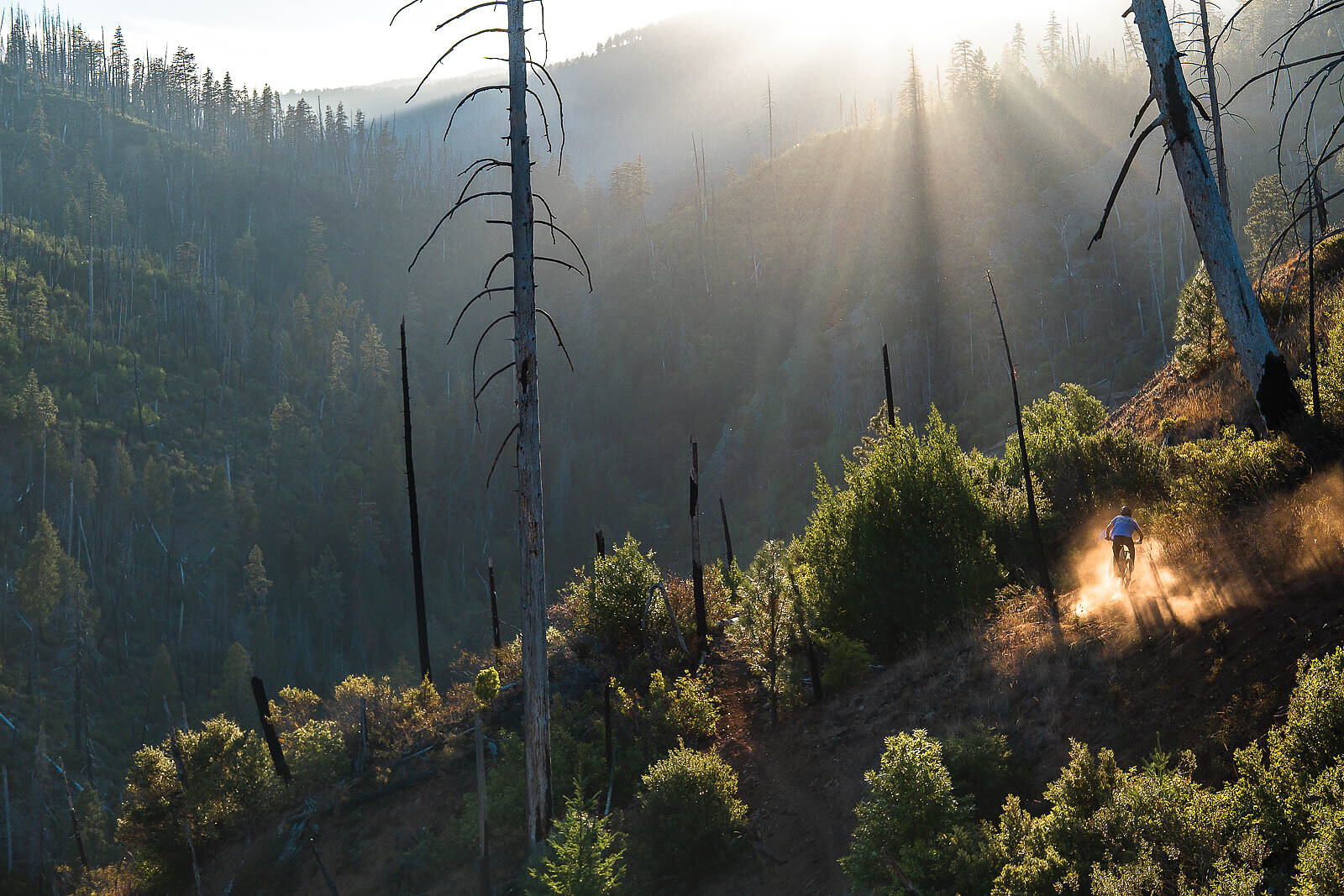

As a test piece, the club worked to rehabilitate the Lower Rogue River trail. On paper, the 12-mile trail seemed like an attractive first step. An iconic trail that had long been overgrown, the Lower Rogue was highlighted in the Regional Trails Plan, began near the historic community of Agness, and tied in neatly with the community’s river-oriented recreation focus on jet boats and fishing. Seeing opportunity, WRCMBA invested more than 500 volunteer hours and $100,000 to complete the project. But, once the trail opened, riders quickly experienced a different reality.
“People rode it once and said, ‘I’m never riding it again,’” Lacey says.
The endless punchy ups and downs on steep, high-consequence sidehill robbed the trail of any flow, as did the skin-shredding, relentless overgrowth. Adding insult to injury, a rockslide obliterated a large section of the trail the following year which left the eastern end of the trail all but impassable.
Undeterred, WRCMBA learned from the project and began searching for trails that, while equally raw, rode much better. Almost immediately, the Pine Grove trail caught the club’s attention. Ending near the historic Cougar Lane Lodge in Agness, the old moto trail descends more than 3,000 feet in six miles, surfing through leaves from tanoak, madrone, and manzanita with stretches of traction-robbing cobble of an ancient riverbed. Easily shuttled on mostly paved logging roads, Pine Grove became the centerpiece of the club’s plans with the Gold Beach Ranger District.
Pine Grove also provided access to the Lawson Creek trail. Plunging nearly 3,500 feet in five miles through volcanic rock and old burn scars to a steep creek gorge before quickly regaining much of that elevation on the other side, Lawson Creek, while raw, was ripe for restoration. Ptarmigan Ptrails spent much of the summer of 2022 restoring the historic tread by hand.
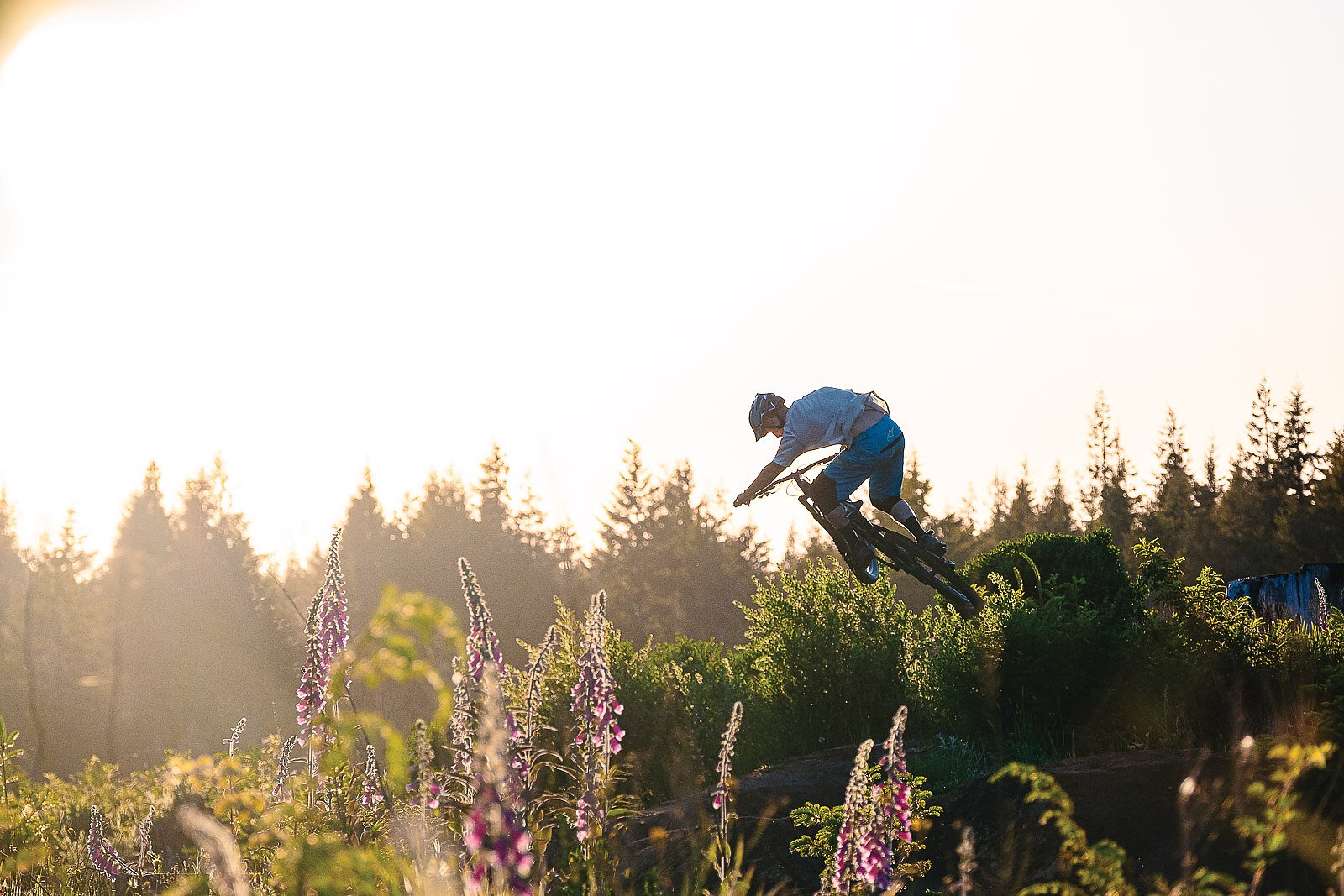
Recently, WRCMBA received grant funding for Ptarmigan to fine-tune Pine Grove, finish restoring the length of the Lawson Creek trail to its terminus at Game Lake, and brush and rebuild the Game Lake trail, which descends nearly 4,500 feet to the Wild and Scenic Illinois River. The goal is to provide a satisfying backcountry bike experience while preserving the timeless essence of the trails. It’s the first tangible step in the Wildhorse Trails Complex Plan, which encompasses historic trail rehabilitation and new trail construction in locations ranging from Gold Beach to Grants Pass on the Interstate 5 corridor. As part of that effort, the club has had to apply relentless pressure on the local ranger district to sign an unfunded cost-sharing agreement to maintain existing trails.
“Whiskey Run was just kind of handed in the community’s lap—there was so little input to get it off the ground, because the county commissioners immediately supported it,” Kessler says. “Lower Rogue is more like the status quo.”
In the seven years since WRCMBA was formed, it has seen three Gold Beach Ranger District recreation managers come and go. Grant deadlines came and went with the turnover, leaving unsigned documents sitting on federal bureaucrats’ desks.
Dealing with the state government has not been any easier. At Cape Sebastian State Scenic Corridor, where Lacey’s initial foray into coastal mountain biking languished, Oregon State Parks rejected a club proposal to build a new shoreline trail network, citing the park system’s reluctance to host anything but beginner bike trails. North of Gold Beach, at Humbug Mountain State Park, the state let lapse a grant that WRCMBA had won to build bike trails there.
“Dave is doing great work putting together real proposals to get the Forest Service and State Parks to make things happen,” says youth pastor and WRCMBA board co-chair Anthony Darling, who represents the southern half of the club’s territory. “We have been hounding them for a long time, and we’ve been putting our money where our mouth is. We’re just playing the long game. It’s outlasting the grumpy old people.”

Kessler and Lacey now spend the days that they’re not in the surf or on singletrack stalking the halls of congress trying to convince their federal elected officials to encourage the Forest Service to measure success via new recreation opportunities created, rather than just board feet of timber produced.
“What we’re trying to tell the Forest Service, is that if you don’t push these investments in these backcountry trail systems, no one is going to be there to have a connection to these things you’re trying to conserve,” Kessler says. “When you talk to people who grew up in the Gold Beach area in the ‘60s and ‘70s, it’s a defining part of their ego. That’s a lost experience in America.”
It hasn’t been easy, but Kessler is beginning to see movement in the relationship between WRCMBA and the Forest Service.
“We’re all kind of gluttons for punishment on the south coast,” Kessler says, citing the constant hard work needed to keep the project aloft. “But I’m not going anywhere.”
Kessler and Lacey would like others in Gold Beach, Port Orford, and other small towns along the southern Oregon Coast to not go anywhere either. They know this hinges on people’s reasons to stay put, whether it’s the sheep and cattle ranchers looking to preserve their land without having to convert it to short-term rentals, or high schoolers needing financial and lifestyle incentives to stay once they graduate.
“We don’t have many people that ride mountain bikes, but we are fighting for the same things that the old timers are fighting for: public lands that they used to enjoy and have watched deteriorate and burn up in fire,” Darling says.
“The locals you see at Whiskey Run, they’re a different breed of people,” Gross says. “A lot of guys hunt and fish, and they’re doing the bike riding for fitness for hunting. We wear our spandex sometimes and we wear our camo sometimes. It’s more of a blended culture.”


While WRCMBA continues to fight for the Wildhorse trails, they haven’t let up on trail construction elsewhere. Ptarmigan has built the first of at least five miles of beginner and intermediate-oriented trails at 100 Acre Wood in Coquille, ten minutes west of Bandon, as well as the moto-oriented Winchester trail system north of Whiskey Run, also on working county forest land. The club also recently began advocating for the reopening of dunes trails that had historically been open to motor vehicles.
Meanwhile, Whiskey Run has brought regional and national attention to the riding possibilities on the southern Oregon Coast. Several new bike shops have opened in recent years, and Lacey has added a mountain bike shuttle service to his South Coast Tours guiding business.
“If you have two Whiskey Run-type quality trail systems within an hour of one another, that elevates the whole area,” Lacey said. “That’s been our goal the whole time: two really good destinations, two major anchors, and then a couple of other things.”
Lacey, along with others at the mountain bike club, hope that between the shuttle-ready backcountry trails of the Wildhorse trails complex and the purpose-built flow of Whiskey Run right off Highway 101, the area could be the southern linchpin of a border-to-border Oregon Coast bike road trip, along with Pacific City and Seaside’s Klootchy Creek trail systems. Lacey says it’s an arms race between those communities and WRCMBA to build the best stop on what they refer to as a place to “ride the dirt wave.”
As that dirt wave crests, WRCMBA hopes to capitalize on the public’s demand for bike-optimized trails. Already, they are beginning to see vans adorned with surfboards and bikes; the county recently approved a new overnight parking area in a freshly logged section of Whiskey Run.
“I am a surfer, before I left Florida and ran away to Alaska,” Kessler says. “The surfing world is so cyclical, and biking is at the same point. That’s what trailbuilding and trails in general have shown me—everyone wants to just have fun on trail on their bikes.”
Getting to that point on the Wild Rivers Coast has been a balancing act between preserving a sense of history with the acceptance of the transient nature of trails and the people who use them—all while standing firm and outlasting bureaucracy. Lacey, Kessler, and other locals are patiently waiting for the break. They know that individual waves are fleeting, but flow is forever.
![“Brett Rheeder’s front flip off the start drop at Crankworx in 2019 was sure impressive but also a lead up to a first-ever windshield wiper in competition,” said photographer Paris Gore. “Although Emil [Johansson] took the win, Brett was on a roll of a year and took the overall FMB World Championship win. I just remember at the time some of these tricks were still so new to competition—it was mind-blowing to witness.” Photo: Paris Gore | 2019](https://freehub.com/sites/freehub/files/styles/grid_teaser/public/articles/Decades_in_the_Making_Opener.jpg)
